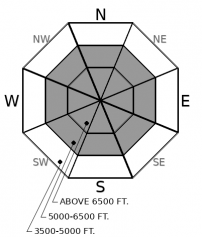| Friday | Friday Night | Saturday | |
|---|---|---|---|
| Cloud Cover: | Overcast | Overcast | Overcast |
| Temperatures: | 22 to 27 deg. F. | 10 to 15 deg. F. | 17 to 22 deg. F. |
| Wind Direction: | Southwest | Southwest | South |
| Wind Speed: | 7 to 12, gusting to 25 | 10 to 15, gusting to 30 | 5 to 10, gusting to 20 |
| Snowfall: | 3 to 6 in. | 2 to 4 in. | 3 to 5 in. |
| Snow Line: | 2500 | 1500 | 1000 |
Whitefish Range
Flathead Range and Glacier National Park
How to read the forecast
New storm slabs are developing on top of recent low density snow, surface hoar, and crusts. The fresh slabs are also adding yet more weight to deeply buried weak layers. Dangerous avalanche conditions will require conservative decision making today. Monitor new snow totals and look for areas where the wind has made slabs denser. Shooting cracks and collapses are red flags telling you to avoid avalanche terrain.

3. Considerable
?
Above 6500 ft.
3. Considerable
?
5000-6500 ft.
2. Moderate
?
3500-5000 ft.
- 1. Low
- 2. Moderate
- 3. Considerable
- 4. High
- 5. Extreme
-
Type ?
-
Aspect/Elevation ?

-
Likelihood ?CertainVery LikelyLikelyPossible
 Unlikely
Unlikely -
Size ?HistoricVery LargeLargeSmall

Winds increased yesterday afternoon and snow began falling overnight. 6 to 8 inches of new snowfall will continue throughout today. New slabs will bond poorly to low density snow, surface hoar, and sun crusts from yesterday. Monitor snow totals and watch for wind thickened drifts. Be wary of slopes steeper than about 35 degrees, especially on the leeward sides of ridges and above terrain traps. Shooting cracks and whumpfing are red flags directing you to low angled terrain.
-
Type ?
-
Aspect/Elevation ?

-
Likelihood ?CertainVery LikelyLikelyPossible
 Unlikely
Unlikely -
Size ?HistoricVery LargeLargeSmall

New loading means that triggering buried weak layers of facets, crusts, and surface hoar remains a possibility today. We have several reports of avalanches and collapses failing on the Groundhog Day crust from the recent storm. Collapses on that layer continued yesterday in the Middle Fork and on Mt. Brown where it was found between 2 and 4 feet deep. Guy found the deeply buried surface hoar from mid-January to be alive and well in the northern Whitefish Range. New avalanches failing on these layers will be large and dangerous. Whumpfing and deep shooting cracks are direct signs of instability underneath of you. Play it safe by choosing low-angled slopes away from convexities and terrain traps.
The 2-3 feet of snow from Tuesday/Wednesday settled quickly. A widespread natural avalanche cycle ran mid-storm with several reports of storm slabs stepping down to the Groundhog Day crust. By yesterday, observers reported few signs of lingering instability.
A few collapses were reported failing on the Groundhog crust in the Middle Fork and on Mt. Brown. That crust is now buried 2-4 feet deep across the forecast area. We have an informal report of a rider triggering a small slab that stepped down into a buried surface hoar layer. We expected to find evidence of some very large deep slab avalanches in the wake of the recent storm, and Zach reported a very large avalanche that we expect failed on a buried weak layer, or it may have been a large slab of wind-drifted snow. Guy did see reactive surface hoar buried 3-4 feet in the northern Whitefish Range. Slabs that fail on buried weak layers, or smaller slides that step down and trigger them could be very large and destructive.
Clear weather Wednesday night left a layer of surface hoar at middle and upper elevations and sun crusts have developed on southerly slopes. The new snow that began overnight will have trouble bonding to these weak surfaces. New storm slabs will be sensitive, especially where the most snow accumulates. Where weak layers underlie the new snow, slabs may be less predictable and propagate further than you expect. Choose simple terrain and watch your slope angles today.
Expect steady snowfall today with light to moderate southwesterly winds. Snowfall tapers off tonight before returning Saturday, along with cooler temperatures. Another arctic intrusion is forecast for early Sunday morning.
This forecast applies only to backcountry areas outside established ski area boundaries. The forecast describes general avalanche conditions and local variations always occur. This forecast expires at midnight on the posted day unless otherwise noted. The information in this forecast is provided by the USDA Forest Service who is solely responsible for its content.



























